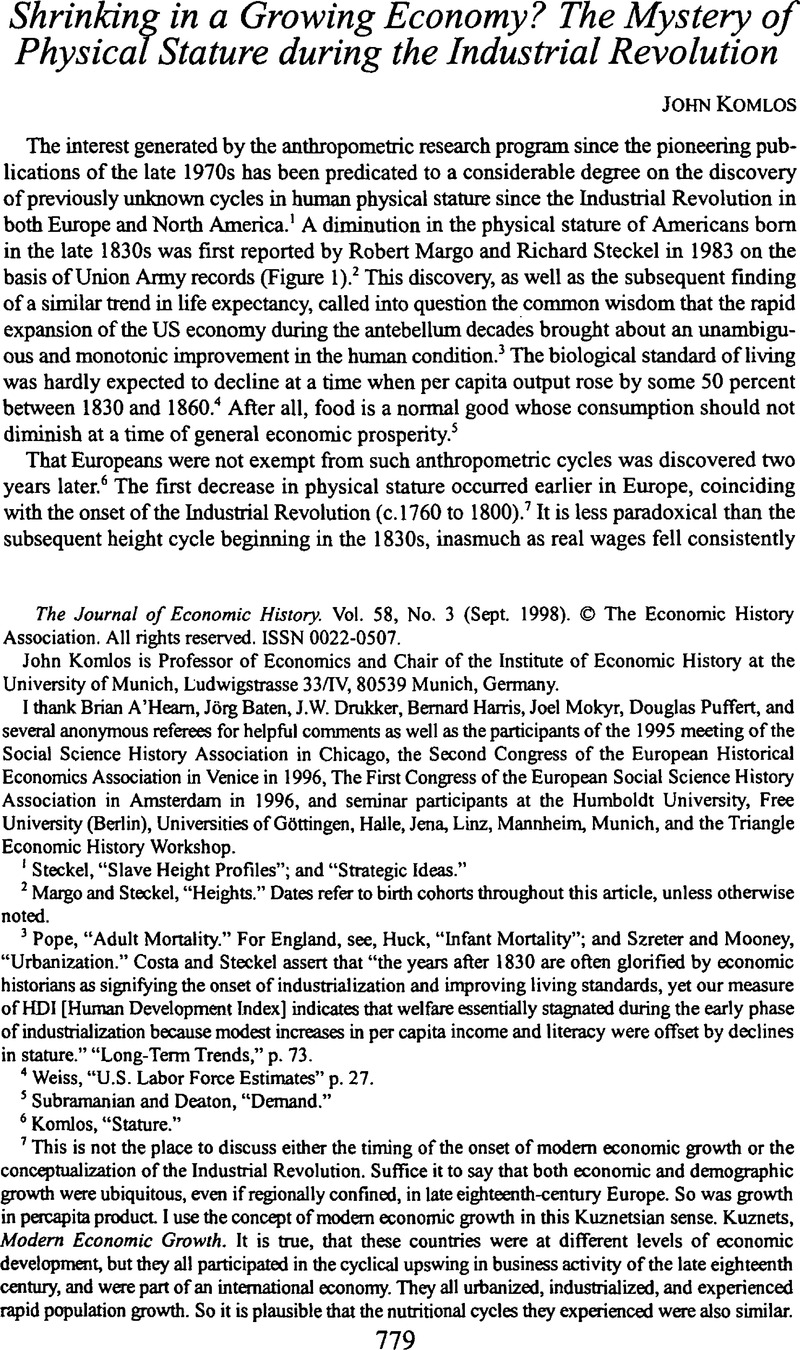Crossref Citations
This article has been cited by the following publications. This list is generated based on data provided by Crossref.
Komlos, John
1999.
On the Biological Standard of Living in Russia and the Soviet Union.
Slavic Review,
Vol. 58,
Issue. 1,
p.
71.
Johansson, S. Ryan
2000.
Macro and Micro Perspectives on Mortality History.
Historical Methods: A Journal of Quantitative and Interdisciplinary History,
Vol. 33,
Issue. 2,
p.
59.
van der Eng, Pierre
2000.
Food for Growth: Trends in Indonesia's Food Supply, 1880-1995.
The Journal of Interdisciplinary History,
Vol. 30,
Issue. 4,
p.
591.
Komlos, John
2001.
Vol. 20,
Issue. ,
p.
223.
Komlos, John
and
Nefedov, Sergey
2002.
A Compact Macromodel of Pre-Industrial Population Growth.
Historical Methods: A Journal of Quantitative and Interdisciplinary History,
Vol. 35,
Issue. 2,
p.
92.
Komlos, J.
and
Kriwy, P.
2002.
Social status and adult heights in the two Germanies.
Annals of Human Biology,
Vol. 29,
Issue. 6,
p.
641.
Baten, Joerg
2002.
Climate Development and History of the North Atlantic Realm.
p.
327.
Komlos, John
and
Kriwy, Peter
2003.
The Biological Standard of Living in the Two Germanies.
German Economic Review,
Vol. 4,
Issue. 4,
p.
459.
Oxley, Deborah
2003.
‘The seat of death and terror’: urbanization, stunting, and smallpox.
The Economic History Review,
Vol. 56,
Issue. 4,
p.
623.
Komlos, J
2003.
Editor’s introduction.
Economics & Human Biology,
Vol. 1,
Issue. 1,
p.
v.
Heyberger, Laurent
2003.
Estimer la stature des Alsaciens (1780-1794).
Histoire & mesure,
Vol. XVIII,
Issue. 1/2,
p.
73.
Osmani, Siddiq
and
Sen, Amartya
2003.
The hidden penalties of gender inequality: fetal origins of ill-health.
Economics & Human Biology,
Vol. 1,
Issue. 1,
p.
105.
Federico, Giovanni
2003.
Heights, calories and welfare: a new perspective on Italian industrialization, 1854–1913.
Economics & Human Biology,
Vol. 1,
Issue. 3,
p.
289.
Escudero, Antonio
and
Simón, Hipólito J.
2003.
El bienestar en España: una perspectiva de largo plazo, 1850–1991.
Revista de Historia Económica / Journal of Iberian and Latin American Economic History,
Vol. 21,
Issue. 3,
p.
525.
Woitek, Ulrich
2003.
Height cycles in the 18th and 19th centuries.
Economics & Human Biology,
Vol. 1,
Issue. 2,
p.
243.
Lang, Stefan
and
Sunder, Marco
2003.
Non-parametric regression with BayesX: a flexible estimation of trends in human physical stature in 19th century America.
Economics & Human Biology,
Vol. 1,
Issue. 1,
p.
77.
López-Alonso, Moramay
and
Condey, Raúl Porras
2003.
The ups and downs of Mexican economic growth: the biological standard of living and inequality, 1870–1950.
Economics & Human Biology,
Vol. 1,
Issue. 2,
p.
169.
Eiben, O.G
and
Mascie-Taylor, C.G.N
2004.
Children’s growth and socio-economic status in Hungary.
Economics & Human Biology,
Vol. 2,
Issue. 2,
p.
295.
Komlos, John
and
Baten, Jörg
2004.
Looking Backward and Looking Forward.
Social Science History,
Vol. 28,
Issue. 2,
p.
191.
Alter, George
2004.
Height, frailty, and the standard of living: Modelling the effects of diet and disease on declining mortality and increasing height.
Population Studies,
Vol. 58,
Issue. 3,
p.
265.



